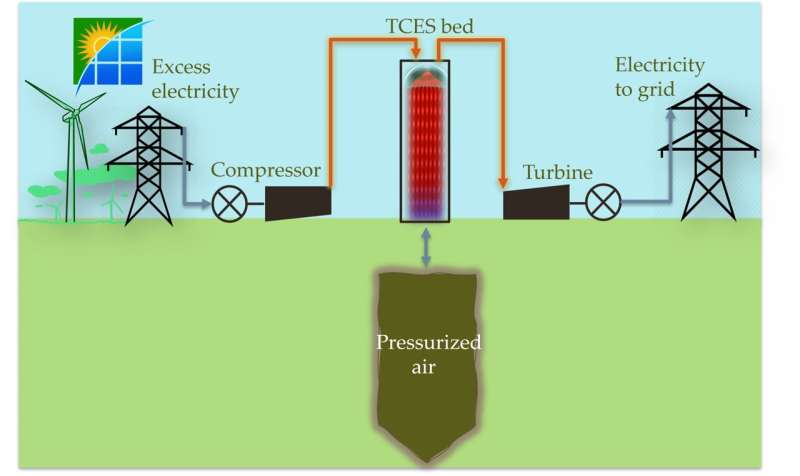
Research by the Oregon State University College of Engineering has uncovered a way to improve the efficiency of a type of grid-scale storage crucial for a global transition toward renewable energy.
Moving toward net-zero carbon emissions means dealing with the intermittent, unpredictable nature of green power sources such as wind and solar and also overcoming supply and demand mismatches, said OSU’s Nick AuYeung, who led the study along with Ph.D. student Fuqiong Lei.
Those challenges, AuYeung notes, necessitate energy storage through means beyond pumped hydro plants, which feature a turbine between two water reservoirs of different elevations, and huge lithium-ion batteries.
The computer modeling study spearheaded by AuYeung, associate professor of chemical engineering, and Lei found that one of those additional energy storage technologies, compressed air, could be improved via chemical reactions.
The reversible reactions can absorb energy in the form of heat and subsequently conserve energy that would otherwise be lost.
Findings, published in Energy Conversion and Management, are also applicable to a related technology, liquid air energy storage, AuYeung said.
As their names suggest, the liquid and compressed air techniques harness energy that can be accessed when needed by allowing stored air—either pressurized or cooled to a liquid form—to expand and pass through electricity-generating turbines.
However, both CAES, as compressed air energy storage is typically expressed, and LAES (liquid air) score somewhat poorly in a category known as round-trip efficiency, AuYeung explains. With either, only about half the energy put in can be pulled out—think of it as making a bank deposit of $1,000 but, due to various charges, only about $500 is available for withdrawal.
“An advantage of CAES is that it allows energy to be stored at large scales, which is a hurdle for electrochemical battery technologies,” he said. “But a major challenge for traditional CAES is reaching high round-trip efficiency.”
In a conventional CAES process, electricity is used to compress air, and the compressed air is stored below ground in a cavern or in a pressure vessel, AuYeung said. When the air is compressed, its temperature rises, but that heat is typically regarded as waste and thus goes unrecovered and unused.
“To discharge the air to produce power, it’s usually heated with natural gas to increase the turbine feed’s enthalpy, the total system energy,” he said. “Factoring in heat lost during storage, the result is that the overall round-trip efficiency—the ratio of turbine output work to work consumed through compression—is only between 40 percent and 50 percent.”
AuYeung and collaborators at OSU, Mississippi State University and Michigan State University came up with a storage scheme to improve that efficiency—thermochemically recovering lost heat—and developed a mathematical model for its design and operation. An advantage of thermochemical energy storage, or TCES, over other methods is a higher energy density made possible by capturing heat in the form of chemical bonds, he said.
Using their model, the researchers analyzed the performance of TCES incorporated into thermal energy storage via “packed beds”—vessels filled with some kind of solid packing medium, where energy reaches the solid by means of a heat transfer fluid such as air. The filler material is typically alumina, ceramic or crushed rock.
Packed beds are classified as “sensible” storage because energy is harnessed by virtue of the filler material changing temperature.
“We looked at TCES with packed beds filled with rocks and barium oxides,” AuYeung said. “Our results showed a similar round-trip efficiency between beds with TCES and beds without because of the relatively low heat capacity and heat of reaction for the barium oxides. We got to 60 percent round-trip efficiency for both systems with a 20-hour storage time after charge. Other means of thermal storage cannot store the heat for long periods of time since they cool down.”
Importantly, he noted, with TCES material placed atop the packed beds, there was a more stable turbine air inlet temperature—higher for longer—which is a key to optimal power generation and thus desirable to utilities. In addition, AuYeung said the model shows that with future advanced materials, round-trip efficiency and storage time could improve as well.
“To better illustrate the potential of the concept, we came up with a hypothetical material with the same heat capacity as rocks but a thermochemical storage capacity three times that of barium oxides, and we looked at that hypothetical material in our model,” he said. “Results showed that a potential round-trip efficiency improvement of more than 5 percent can be obtained, as well as longer storage durations. Also, 45 percent less filler volume would be needed to achieve storage capacity similar to rock-filled beds.”
AuYeung said the barium chemistry the initial model was based on was the most obvious that came to mind for the researchers’ but has a downside because its heat capacity is fairly low.
“There are non-oxygen chemistries such as hydrates and carbonates that have the hypothetical properties—high heat capacity, high heat of reaction—we looked at, but right now we haven’t identified one for a redox material that operates on oxygen swing,” he said. “A next step perhaps for us, or for others with more materials expertise, would be to try to discover new materials.”